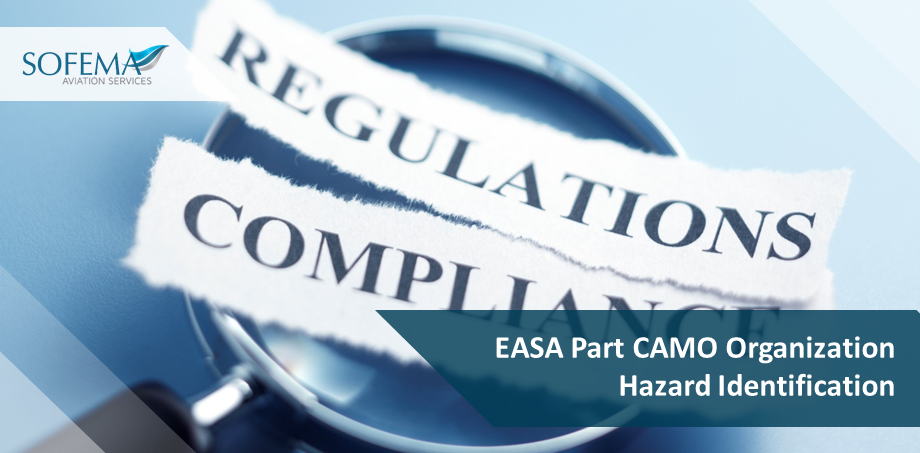Sofema Aviation Services (SAS) considers the Implementation of a Safety Management System within an EASA Part CAMO Organisation
Presented by Steve Bentley – CEO of Sofema Aviation Services & SofemaOnline.
With the introduction of Part CAMO, effective March 24, 2020, EASA has introduced the familiar concept of a Management System including Safety Management SMS & Compliance Monitoring (The old term of Quality System is discontinued) Section A for Industry & Section B for the Regulatory Authority are retained.
Existing Part M Subpart G approvals will no longer be valid from 24 September 2021 and it is the responsibility of each organisation to ensure an effective transition to the new Part CAMO environment.
This document provides a simple overview of SMS-related elements which will need to be adopted by the EASA Part CAMO-compliant Organisation.
Note – It is a redaction of the original document to provide focus and clarity.
Introduction
Opinion No 06/2016 brings together many years of knowledge & experience in the delivery of regulations related to the implementation of Safety Management Systems in particular in relation to EASA Part CAMO Organisations.
The purpose of Opinion 06/2016 concerns the embodiment of the safety management system (SMS) requirements into Commission Regulation (EU) No 1321/2014 — SMS in Part-M.
This Opinion introduces safety management in continuing airworthiness management through the creation of a new Annex Vc ‘Part-CAMO’ to Commission Regulation (EU) No 1321/2014 dedicated to continuing airworthiness management organisations (CAMOs), which are managing aircraft operated by licensed air carriers and/or complex motor-powered aircraft (CMPA).
Note – The SMS requirement will apply to an estimated 65% of all currently approved CAMOs.
General Comments
1/ Only Part-CAMO-approved continuing airworthiness management organisations will be required to implement SMS based on a set of proportional management system requirements.
2/ The new Part-CAMO includes the requirement for the nomination of a person or group of persons fulfilling the role of safety manager at IR level.
3/ Part-CAMO-approved organisations may also manage the continuing airworthiness of other than CMPA and aircraft not used by licensed air carriers.
4/ The new Annex Vc ‘Part-CAMO’ will supersede the current Subpart G of Annex I (Part-M) to Commission Regulation (EU) No 1321/2014.
5/ Part-CAMO-approved organisations may also manage the continuing airworthiness of other than CMPA and aircraft not used by licensed air carriers.
6/ The new Part-CAMO will not maintain the distinction between complex and non-complex organisations as defined in AMC1 to ORA/ORO.GEN.200(b). Organisations currently following the set of management system AMC for non-complex organisations will need to upgrade to a new set of common AMCs applicable to all organisations.
7/ This may mean for example that they will be required to establish a safety review board (SRB) ideally covering all their regulated activities, which is expected to support their safety management and provide positive safety impacts.
Note the use of the word “may” – in the smallest of CAMO Organisations when accepted by the Competent Authority this can role can be performed by the Accountable Manager.
Development – Outcomes
The proposed changes are expected to:
a) Increase the level of safety in continuing airworthiness management and maintenance of aircraft operated by licensed air carriers and of CMPA; and
b) Facilitate the implementation of single management systems by multiple-approved organisations and streamline the related oversight.
Safety Management System Elements Required to Demonstrate Compliance
Continuing Airworthiness Management Organisations (CAMO’s) managing aircraft used by licensed air carriers and/or CMPA that have not yet implemented SMS will need to implement the additional processes and organisational changes in order to comply with the new Part-CAMO are detailed as follows :
(a) Nomination of a person or group of persons fulfilling the role of safety manager:
(b) Processes for hazard identification, including incident investigation and an internal safety reporting scheme;
(c) Processes for safety risk assessment, analysis, mitigation and follow-up;
(d) Implementation of an internal safety reporting scheme:
Note – Such internal reporting scheme is also a prerequisite for mandatory and voluntary reporting as required by Regulation (EU) No 376/2014.
(e) Safety action planning, including the establishment of an SRB composed of line managers, the accountable manager and the safety manager;
(f) Safety performance monitoring to ensure that safety objectives will be met;
(g) Emergency response planning;
(h) A process for the management of change, in particular, to manage related risks, making use of the safety risk management processes (point (c));
(i) Safety training, including human factors training and safety promotion:
(j) Record-keeping related to management system key processes.
What`s more :
Next Steps
Follow this link to our Library to find & download related documents for Free.
Please see Sofema Aviation Services or Sofema Online for regulatory compliant and vocational training courses – email us at team@sassofia.com for more information about our services.
.
Tags:
CAMO, Aviation Safety Management System, Aviation SMS, EASA Part – CAMO, Opinion 06/2016




